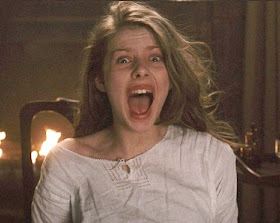You’ve heard a hundred movies boast the tagline, “based on a true story”, or, “inspired by real events.” And with a horror film, especially one with supernatural elements, it’s almost impossible not to scoff and say, “Yeah, right.” Although it’s easy to dismiss such a notion, perhaps there is a small part of you that wonders, “Is it really possible?”
Well, that is precisely what True Story Tuesday is about, finding the truth behind the tall tales and the fact from the fiction. So, welcome back, my friends, to another helping.
One such film to claim depictions of true events was the 2005 film, An American Haunting, directed by Courtney Soloman. Although the film takes place in two time periods, it is set predominately in early 19th century and tells the tale of the Bell family. The father, John Bell (Donald Sutherland) is accused of stealing a local woman’s—and alleged witch—land. When he is given no real punishment the ‘witch’, Kate Batts (Gaye Brown), threatens to curse the Bell daughter. The family soon falls victim to supernatural forces, which torment the daughter, Betsy Bell (Rachel Hurd-Wood), both physically and mentally.
 |
sketching of the Bell cabin
|
 |
Rachel Hurd-Wood as Betsy Bell
|
By this time the entity had found a voice and would sing hymns, quote the Bible, and even carry on intelligent conversation with people. According to the story, once when asked who or what it was, the disembodied voice claimed to be a witch sent by a local woman named Kate Batts. From then on people would refer to the spirit as, “The Bell Witch”. The haunting finally came to an end when John died after he was apparently poisoned.
In 1894 author Martin Van Buran Ingram released An Authenticated History of the Bell Witch, which details all accounts of the Bell Witch haunting. Ingram claimed to have based the book off of a diary written by one of the Bell sons, Richard, who was around six-years-old at the time but allegedly did not pen his diary until adulthood; however, no evidence of the journal exists, and the only person to have seen it is the author, making many believe that he invented the entire story since he had no real sources.
There are still some who continue to believe the Bell Witch legend, and there is a farm in Adams that is dedicated to it. There have also been several other films inspired by the tale, including Bell Witch Haunting (2004), and Bell Witch: The Movie (2007).
While it is an interesting story, and even inspired a decent film, one can hardly go around claiming the story to be true. In this case, the infamous tagline was misleading and disappointing and probably would have turned out better if it would have just been presented as fiction.



No comments:
Post a Comment